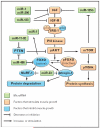MicroRNA in myogenesis and muscle atrophy
- PMID: 23449000
- PMCID: PMC3967234
- DOI: 10.1097/MCO.0b013e32835f81b9
MicroRNA in myogenesis and muscle atrophy
Abstract
Purpose of review: To understand the impact of microRNA on myogenesis and muscle wasting in order to provide valuable information for clinical investigation.
Recent findings: Muscle wasting increases the risk of morbidity/mortality in primary muscle diseases, secondary muscle disorders and elderly population. Muscle mass is controlled by several different signalling pathways. Insulin-like growth factor/PI3K/Akt is a positive signalling pathway, as it increases muscle mass by increasing protein synthesis and decreasing protein degradation. This pathway is directly and/or indirectly downregulated by miR-1, miR-133, miR-206 or miR-125b, and upregulated by miR-23a or miR-486. Myostatin and the transforming growth factor-β signalling pathway are negative regulators that cause muscle wasting. An increase of miR-27 reduces myostatin and increases muscle cell proliferation. Muscle regeneration capacity also plays a significant role in the regulation of muscle mass. This review comprehensively describes the effect of microRNA on myoblasts proliferation and differentiation, and summarizes the varied influences of microRNA on different muscle atrophy.
Summary: Growing evidence indicates that microRNAs significantly impact muscle growth, regeneration and metabolism. MicroRNAs have a great potential to become diagnostic and/or prognostic markers, therapeutic agents and therapeutic targets.
Figures

References
Publication types
MeSH terms
Substances
Grants and funding
LinkOut - more resources
Full Text Sources
Other Literature Sources
Research Materials

